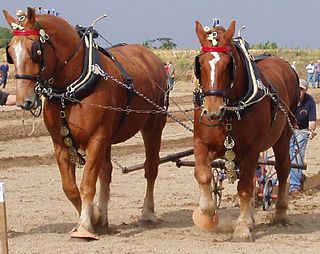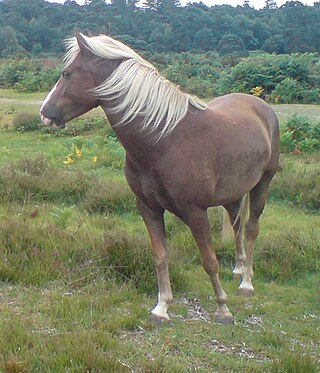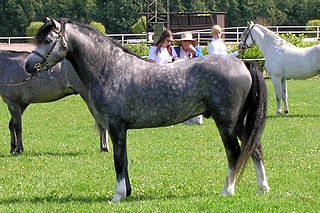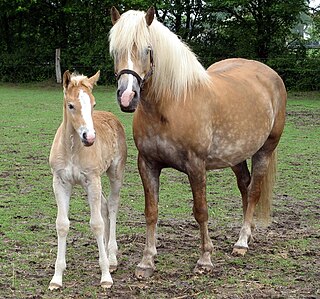
Horse breeding is reproduction in horses, and particularly the human-directed process of selective breeding of animals, particularly purebred horses of a given breed. Planned matings can be used to produce specifically desired characteristics in domesticated horses. Furthermore, modern breeding management and technologies can increase the rate of conception, a healthy pregnancy, and successful foaling.

The Friesian is a horse breed originating in Friesland in north Netherlands. The breed nearly became extinct on more than one occasion. It is classified as a light draught horse, and the modern day Friesian horse is used for riding and driving. The Friesian horse is most known for its all-black coat colour, its long flowing mane and tail, feathering on its legs, a high head carriage, and high stepping action.

The Morgan horse is one of the earliest horse breeds developed in the United States. Tracing back to the foundation sire Figure, later named Justin Morgan after his best-known owner, as well as mares of the now-extinct Narragansett Pacer breed, Morgans served many roles in 19th-century American history, being used as coach horses and for harness racing, as general riding animals, and as cavalry horses during the American Civil War on both sides of the conflict. Morgans have influenced other major American breeds, including the American Quarter Horse, the American Saddlebred, the Tennessee Walking Horse, and the Standardbred.

The Percheron is a breed of draft horse that originated in the Huisne river valley in western France, part of the former Perche province, from which the breed takes its name. Usually gray or black in color, Percherons are well-muscled, and known for their intelligence and willingness to work. Although their exact origins are unknown, the ancestors of the breed were present in the valley by the 17th century. They are believed to descend from war horses. Over time, they began to be used for pulling stagecoaches; and later, for agriculture and hauling heavy goods. In the late 18th and early 19th centuries, Arabian blood was added to the breed. Exports of Percherons from France rose exponentially in the late 19th century, and the first purely Percheron stud book was created in France in 1893.

A Hanoverian is a Warmblood horse breed originating in Germany, which is often seen in the Olympic Games and other competitive English riding styles, and has won gold medals in all three equestrian Olympic competitions. It is one of the oldest, most numerous, and most successful of the Warmblood breeds. Originally a cavalry horse, infusions of more Thoroughbred blood lightened it to make it more agile and useful for competition. The Hanoverian is known for a good temperament, athleticism, beauty, and grace.

The Lipizzan or Lipizzaner is a European breed of riding horse developed in the Habsburg Empire in the sixteenth century. It is of Baroque type, and is powerful, slow to mature and long-lived; the coat is usually gray.

The Suffolk Horse, also historically known as the Suffolk Punch or Suffolk Sorrel, is an English breed of draught horse. The first part of the name is from the county of Suffolk in East Anglia, and the word "Punch" is an old English word for a short stout person. It is a heavy draught horse which is always chestnut in colour, traditionally spelled "chesnut". Suffolk Punches are known as good doers, and tend to have energetic gaits.

The New Forest pony is one of the recognised mountain and moorland or native pony breeds of the British Isles. Height varies from around 12 to 14.2 hands ; ponies of all heights should be strong, workmanlike, and of a good riding type. They are valued for hardiness, strength, and sure-footedness.

The Cleveland Bay is a breed of horse that originated in England during the 17th century, named after its colouring and the Cleveland district of Yorkshire. It is a well-muscled horse, with legs that are strong but short in relation to the body. The horses are always bay in colour, although a few light hairs in the mane and tail are characteristic of some breed lines. It is the oldest established horse breed in England. The ancestors of the breed were developed during the Middle Ages for use as pack horses, when they gained their nickname of "Chapman Horses". These pack horses were cross-bred with Andalusian and Barb blood, and later with Arabians and Thoroughbreds, to create the Cleveland Bay of today. Over the years, the breed became lighter in frame as they were employed more as carriage and riding horses. The popularity of the Cleveland Bay has greatly fluctuated since it was first imported to the United States in the early nineteenth century. Despite serious declines in the population after the Second World War, the breed has experienced a resurgence in popularity since the 1970s, although only around 550 horses existed worldwide as of 2006.

The Narragansett Pacer was one of the first recorded horse breeds developed in the United States. It emerged in the 18th century (1700s), and was theorized to have been bred from a mix of English and Spanish breeds, although the exact cross is unknown. The Pacer was associated with, and bred in, the state of Rhode Island and the area of New England; as horse breeding shifted to Kentucky and Tennessee in the late 1700s, it became extinct by the 20th century.

The Canadian is a horse breed from Canada. It is a strong, well-muscled horse, usually dark in colour. It is generally used for riding and driving. Descended from draft and light riding horses imported to Canada in the late 1600s from France, it was later crossed with other British and American breeds. During the 18th century the Canadian horse spread throughout the northeastern US, where it contributed to the development of several horse breeds. During the peak popularity of the breed, three subtypes could be distinguished, a draft horse type, a trotting type and a pacing type. Thousands of horses were exported in the 19th century, many of whom were subsequently killed while acting as cavalry horses in the American Civil War. These exports decreased the purebred Canadian population almost to the point of extinction, prompting the formation of a studbook and the passage of a law against further export.

The Dales Pony is a British breed of pony or small horse. It originated in, and is named for, the Dales of Yorkshire in northern England. It is one the nine native mountain and moorland pony breeds of the United Kingdom, and belongs to the broader Celtic group of ponies which extends from Portugal and northern Spain to Scandinavia.

The Welsh Pony and Cob is a group of four closely-related horse breeds including both pony and cob types, which originated in Wales in the United Kingdom. The four sections within the breed society for the Welsh breeds are primarily distinguished by height, and also by variations in type: the smallest Welsh Mountain Pony ; the slightly taller but refined Welsh Pony of riding type popular as a children's show mount; the small but stocky Welsh Pony of Cob Type, popular for riding and competitive driving; and the tallest, the Welsh Cob, which can be ridden by adults. Welsh ponies and cobs in all sections are known for their good temperament, hardiness, and free-moving gaits.

The Budyonny is a breed of horse from Russia. It was bred as a military horse after the Russian Revolution of 1917; in the twenty-first century it is used as an all-purpose competition horse and for driving.

The Haflinger, also known as the Avelignese, is a breed of horse developed in Austria and northern Italy during the late 19th century. Haflinger horses are relatively small, are always chestnut with flaxen mane and tail, have distinctive gaits described as energetic but smooth, and are well-muscled yet elegant. The breed traces its ancestry to the Middle Ages; several theories for its origin exist. Haflingers, developed for use in mountainous terrain, are known for their hardiness. Their current conformation and appearance are the result of infusions of bloodlines from Arabian and various European breeds into the original native Tyrolean ponies. The foundation sire, 249 Folie, was born in 1874; by 1904, the first breeders' cooperative was formed. All Haflingers can trace their lineage back to Folie through one of seven bloodlines. World Wars I and II, as well as the Great Depression, had a detrimental effect on the breed, and lower-quality animals were used at times to save the breed from extinction. During World War II, breeders focused on horses that were shorter and more draft-like, favored by the military for use as packhorses. The emphasis after the war shifted toward animals of increased refinement and height.

The Mongolian horse is the native horse breed of Mongolia. The breed is purported to be largely unchanged since the time of Genghis Khan. Nomads living in the traditional Mongol fashion still hold more than 3 million animals, which outnumber the country's human population. In Mongolia, the horses live outdoors all year, dealing with temperatures from 30 °C (86 °F) in summer down to −40 °C (−40 °F) in winter, and they graze and search for food on their own. The mare's milk is processed into the national beverage airag. Some animals are slaughtered for meat. Other than that, they serve as riding and transport animals; they are used both for the daily work of the nomads and in horse racing.

Mountain and moorland ponies form a group of several breeds of ponies and small horses native to the British Isles. Many of these breeds are derived from semi-feral ponies kept on moorland or heathland, and some of them still live in this way, as well as being kept as fully domesticated horses for riding, driving, and other draught work, or for horse showing.

The heavy warmbloods are a group of horse breeds primarily from continental Europe. The title includes the Ostfriesen and Alt-Oldenburger ("Old-Oldenburger"), Groningen, and similar horses from Silesia, Saxony-Thuringia, and Bavaria. Breeds like the Hungarian Nonius, Kladruber, and Cleveland Bay are also often classed as "heavy warmbloods." They are the ancestors of the modern warmbloods, and are typically bred by preservation groups to fit the pre-World War I model of the all-purpose utility horse. Unlike the registries of the sport horses that followed them, many heavy warmblood registries maintain closed or partly closed studbooks. However, external evaluation and performance testing of the breeding stock is still a key element in these registries. Many of the heavy warmbloods are selected primarily for family-friendly temperaments.
Studbook selection is a process used in certain breeds of horses to select breeding stock. It allows a breed registry to direct the evolution of the breed towards the ideal by eliminating unhealthy or undesirable animals from the population. The removal of individuals from a population is called culling, and does not suggest killing the animal in question. Typically, culls are castrated or they and their offspring are unable to be registered.

The Yeguada Militar de Jerez de la Frontera, known outside Spain as the Yeguada Militar, is a military Spanish stud farm headquartered in Andalusia, Spain, dedicated to horse breeding of purebred Andalusian horses and Arabian horses. Founded in 1847, it became the state military stud farm in 1893. In the 20th century, as need for cavalry horses declined, the stud's emphasis shifted to become a genetic reservoir to preserve the bloodlines of the Pure Spanish Horse and to continue to breed high quality Arabian horses, with stallions of both breeds being made available to private horse breeders to improve the horses of Spain. Today, there are two facilities located in the Jerez de la Frontera area, one primarily for stallions, the other for mares and foals, as well as multiple stallion depots across the country.



















